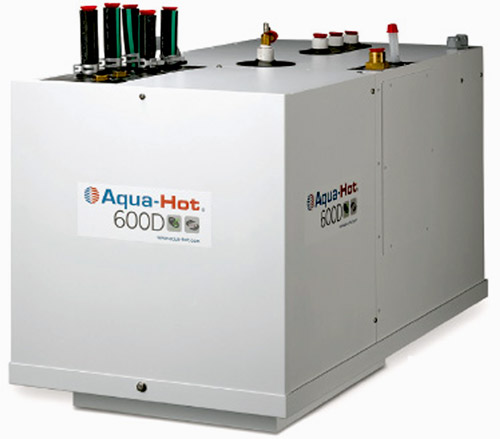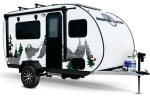Hydronic Heating Systems
RV Basics
Hydronic RV Heating system is complex and expensive, but most efficient, quite, heating air and fresh water, running on diesel, LPG, electric energy as well as engine generated heat….
Hydronic Heating Systems
These are by far most complex, expensive and maintenance requiring RV heaters.
So let’s face it – they are designed for big residential rigs (as the mater of fact only coaches can take full advantage of hydronic systems).
Hydronic heater works like an old residential heating system. It heats the boiler with non-toxic solution of glycol and water (similar to what you use in your car’s engine cooling system). The hot liquid is then pump-circulated via the system of pipes to small heat exchangers (radiators) located throughout the RV. Each radiator is usually assisted by small, temperature controlled fan so the coach’s interior can warm-up quickly and the temperature profile is more uniform.
Additionally, the hot liquid from the boiler is also branched to the extra heat-exchanger for the heating of fresh water (shower, kitchen and bath sinks…). As the result the Hydronic system can not only efficiently heat coach’s interior but also provide “on-demand” hot water. In other words it acts like (and replaces) two traditional RV units: Furnace and Water Heater.
Well, this is just the basic concept; real implementations usually add more useful features making Hydronic Heating systems exceptional and truly residential solutions.
Energy Sources:
Usually, the Hydronic Heater is designed to work with various sources of energy:
Diesel
It’s an obvious choice when you have a diesel-engine RV so the fuel is available. The low-pressure burning process is efficient, safe and relatively clean (low emissions). While some manufacturers claim that this is a “No smoke- No Smell” design, you should expect noticeable exhaust gases from the extra exhaust pipe on the street side of the coach. It may not bother you, but potentially may raise complaints from campground’s neighbors!
Propane (LPG)
Propane is the “cleanest” fuel (in terms of waste gases), widely available and equally important – familiar to most of us (who does not have BBQ).
Electricity.
To diversify the sources of energy, all hydronic systems are designed as dual-energy units. The electricity is considered as the secondary source. Usually it cannot meet full power requirements (heating and water), especially in freezing temperatures. However in chilly weather conditions, the electricity probably is the best (and certainly the cleanest) choice (obviously, it serves as the “last-resort” solution when you run out of diesel or propane).
The diesel (or propane) are primary energy sources, designed to meet full demand for heating and hot water during the winter. As an example, typically the heating power of Hydronic systems will be in the range from 50k – to 85k BTU/h plus. In contrast, the peak power of electric heaters is usually limited to about 2 – 3 kW (approximately 7k-10k BTU).
Note: Typically Hydronic heating systems are designed for diesel or propane (but not both mentioned sources). In other words you have to make decision regarding the primary energy source when ordering the system.

Oasis Hydronic Heater: Model NE-S is a game changer with an 85,000 BTU TRUE Output diesel burner which can maintain 120F potable water at 3 GPM …enough for TWO showers at a time, continuously!
Coach’s Engine
Each combustion engine (be it gasoline, diesel or propane) generates heat that has to be dumped into air. Obviously big engines generate a lot of heat so it seems obvious to turn this potential “waste” into something useful. That is why most (if not all) Hydronic Heating systems have ability to connect into engine’s cooling system either directly or by means of a heat-exchanger to harvest energy that otherwise will be wasted. As the result, you can have fully warmed coach and hot water when driving and all that comes from what normally ends up as the “waste” dumped into air by engine’s radiator.
- Now it may be clear, why coaches have ability to benefit the most from Hydronic systems. In fact connecting two hot-liquid circulation loops is relatively easy in the case of coach but quite complex (and risky) when it comes to travel trailer, fifth wheel or truck camper.
- If both circulating loops are interconnected directly, the Hydronic Heating System can be also used to pre-heat coach’s diesel engine. It is well known that at low temperatures (well below freezing), diesels have problems to start. By “pumping” the hot liquid from the Hydronic system into engine’s cooling circulation loop you can warm it prior to starting!
Air Heating
The hot-liquid is circulated throughout the RV by the network of pipes. Heat exchangers (radiators) are placed in selected locations. Thanks to programmable individual blowers behind each radiator the warm air can be distributed quickly and according to needs. But there is more than that – most Hydronic Heaters offer few heating control zones (typically 3 to 5). It’s accomplished by independent circulation loops with their own pumps. Some are used to control the temperature in bedroom, some in living room or bath, but usually one is reserved for heating the basement (enclosed underbelly with water tanks, plumbing and storage compartments).
Some manufacturers went even farther – instead of using local radiators with fans, they design floors with an embedded network of heating pipes. The result is amazing – friendly warm floor and natural convection enforced heat distribution throughout the coach (no fans, no noise).
If you are familiar with modern, high efficiency residential furnaces running on natural gas, you may know that their exhaust gases are not warm at all (actually they have to be evacuated by the blower, because natural convection will not work). It’s because exhaust gases and air intake run counter-current in a heat exchanger, so most of the heat from exhaust is transferred into the circulated air. Similar approach (although on smaller scale due to the size limitations) is used in some Hydronic Heating systems (example Alde units).
Water heating
Most Hydronic systems provide hot water “on demand” (In other words there is no hot water tank). With enough of peak power typically systems are able to deliver 1.5 to 3 gallons of hot water (at 120 degF / 49 degC) per minute (3 gallons/min should be good enough for simultaneous use of two showers). Systems with lower peak power may temporarily stop heating diverting all power for the purpose of water heating (obviously once the demand for hot water diminishes or ceases, the RV heating section restarts its normal operation. Under normal circumstances it will not be visible to the user because liquid-based heating system has quite good thermal “inertia”.
Some designs solve the problem of peak demand for water by including the small hot water tank (couple of gallons). The water is pre-heat to about 185 degF (85 degC) and when demand arises it is mixed with cold water. The available output should then be sufficient for quick shower.
Like every modern systems, Hydronic heaters are equipped with intelligent Control Panels and several sensors. You can program heating of the individual control zones, energy sources, but there are also functions pre-programmed by the manufacturer. For example when you do not use your RV and you forgot to winterize the water tank, the frost sensor will automatically open the valve and empty the ‘hot water tank’ to prevent its destruction.

Aqua-Hot Hydronic heater: Model 600D is a diesel unit providing 65k BTUs/h of heat and continuous, tank-less hot water at 2.0 GPM....
Average Daily Fuel Consumption
The numbers below are just an indication, because the daily use of fuel / energy highly depends on the weather conditions (outdoor temperatures and wind). Understandably it will be much less in chilly weather and much more in winter’s below freezing temperatures. It also depends on the peak power of a given Hydronic system, hot water use and heating habits.
For diesel units you can expect daily fuel consumption from 1-4 gallons
For propane – it may be in the range from 1-3 gallons
Note that extreme cold temperatures will further increase fuel consumption
Summarizing:
Pros:
- Replaces the functions of furnace and hot water heater (kind of “Two-in-One”.
- Energy efficient (especially when coupled to the engine cooling system)
- Energy-flexible (usually designed for 3 sources – either diesel or propane then electricity and RV engine heat)
- Quite operation and excellent uniformity of interior temperature.
- Can be set-up in climate-zones (for better comfort but also efficiency).
- Programmable control system
- Can heat the enclosed underbelly (circulation system is installed in the basement so automatically it can also protect the water tanks and plumbing). From this point of view, the hydronic Heaters are ideal for all-season coaches.
Some also claim that the Hydronic Heater can pre-heat the engine in winter (in this case the heat will be transferred from the Hydronic Heater to the engine cooling system). But it seems a bit questionable, because to be effective you will have to have control of the engine’s water pump what normally is not the case or directly connect two systems (a bit risky for the engine).

Cutaway view of the Alde unit (visible propane combustion chamber, glycol plumbing, electric heater and water jacket surrounding the chamber).
Cons:
- Very expensive (you have to be really “hard-to-die” RV-er to quickly recover the investment or simply a “gentlemen” (as goes an English saying – “Gentlemen do not talk about money, they just have it”
- They are not add-ons, while the heater itself can be installed in an exterior storage compartment the whole plumbing system distributing hot liquid throughout the coach requires factory installation at an appropriate production stage.
- Requires periodic maintenance, repairs are costly.
- Need electrical energy (12V from battery for pump(s) and fans). With multiple pumps and fans it may be a “noticeable” load for batteries.
- Exhaust gases (pipe is usually in the middle of the coach on the driver side). You can expect noticeable smell and potentially complaints from neighbors on crowded campground.
Most popular manufacturers of Hydronic Heating systems for Recreational Vehicles are Oasis, Aqua-Hot, Alde….
Go back to: --> RV Basics
or see reviews of conventional RV heaters: --> RV Heaters for chilly weather
Note: Check with the manufacturer and / or authorized RV Dealer for the up-to-date list of features, options as well as latest specifications. These written above may not be accurate and certainly are subject to change by the factory. We are not responsible for any inaccuracy, the above text is provided only for the general information.
This review was written based on publicly available information for the benefits of the community of RV-ers. We do not receive any gratification or financial benefits from RV manufacturers, dealers, and any other promoters of RVs.
We are NOT involved in sale and/or retail of RVs!
.


